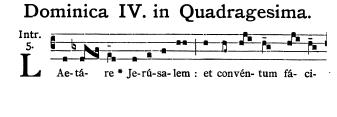|
作者
|
內容
|
|
stefano
|
Posted -
2006/12/13 下午 03:28:48
|
|
|
我只知將臨期第三主日與四旬期第四主日也稱為喜樂主日. 我只知鐸品可於當主日穿粉紅祭衣, 但到底是什麼來的呢???
|
|
edward
|
Posted -
2006/12/13 下午 03:57:19
|
|
|
按照羅馬彌撒經書,將臨期第三主日進台詠的第一個字是「Gaudete」,有喜樂之意,故稱之為「喜樂主日」。

至於四旬期第四主日,進台詠的第一個字是「Laetare」,有「歡喜」之意,所以稱為「歡喜主日」。

|
|
stefano
|
Posted -
2006/12/13 下午 04:05:31
|
|
|
edward,
是不是沒有其他的意思了???
|
|
edward
|
Posted -
2006/12/13 下午 04:13:43
|
|
|
在將臨期和四旬期的彌撒中,禮儀是以沉實和樸素為主調,主禮以紫色作為祭披的色彩。然而,該兩個主日卻彷如一個變奏,令大家記起:在醒寤預備和克己懺悔之中,亦不忘喜樂。
那兩個主日彌撒的讀經之中,亦是有以喜樂為主題的。


或者你也可以找一找呢。
|
|
stefano
|
Posted -
2006/12/13 下午 04:15:19
|
|
|
thx... 我會再找一找吧
|
|
秀永明子
|
Posted -
2006/12/14 上午 11:51:54
|
|
|
Stephano 先生: 未知有否興趣參與長沙灣的拉丁文彌撒? Dec 16th (Sat) 3 pm.
www.tridentine.catholic.org.hk
|
|
stefano
|
Posted -
2006/12/14 下午 06:43:39
|
|
|
秀永明子弟兄:
多謝閣下的邀請, 但可惜未有時間, 而本身自己的團體也有感恩聖祭. 我是一個平信徒, 但對禮儀有特別的興趣, 所有會從多方面留意.
而有很多東西也不明白.
|
|
fabi
|
Posted -
2006/12/17 下午 09:31:27
|
|
|
將臨期第三主日 之喜樂主日
~ 進台詠 (斐4:4-6)
你們在主內應當常常喜樂,我再說:你們應當喜樂! 你們的寬仁應當叫眾人知道: 主快來了!
你們什麼也不要掛慮, 只在一切事上,以懇求和祈禱, 懷著感謝之心, 向天主呈上你們的請求. 光榮歸於父...
|
|
fabi
|
Posted -
2006/12/18 下午 11:25:45
|
|
|
edward:
將臨期第4主日進台詠是「Rorate caeli desuper」, 的第一個字'Rorate' can I say "Rorate Sunday" or..??
|
|
Michael Wu
|
Posted -
2007/7/12 上午 07:03:57
|
|
|
Gaudete Sunday
The third Sunday of Advent, so called from the first word of the Introit at Mass (Gaudete, i.e. Rejoice). The season of Advent originated as a fast of forty days in preparation for Christmas, commencing on the day after the feast of St. Martin (12 November), whence it was often called "St. Martin's Lent"-- a name by which it was known as early as the fifth century. The introduction of the Advent fast cannot be placed much earlier, because there is no evidence of Christmas being kept on 25 December before the end of the fourth century (Duchesne, "Origines du culte chrétien", Paris, 1889), and the preparation for the feast could not have been of earlier date than the feast itself. In the ninth century, the duration of Advent was reduced to four weeks, the first allusion to the shortened season being in a letter of St. Nicholas I (858-867) to the Bulgarians, and by the twelfth century the fast had been replaced by simple abstinence. St. Gregory the Great was the first to draw up an Office for the Advent season, and the Gregorian Sacramentary is the earliest to provide Masses for the Sundays of Advent. In both Office and Mass provision is made for five Sundays, but by the tenth century four was the usual number, though some churches of France observed five as late as the thirteenth century. Notwithstanding all these modifications, however, Advent still preserved most of the characteristics of a penitential seasons which made it a kind of counterpart to Lent, the middle (or third) Sunday corresponding with Laetare or Mid-Lent Sunday. On it, as on Laetare Sunday, the organ and flowers, forbidden during the rest of the season, were, permitted to be used; rose-coloured vestments were allowed instead of purple (or black, as formerly); the decon and subdeacon reassumed the dalmatic and tunicle at the chief Mass, and cardinals wore rose-colour instead of purple. All these distinguishing marks have continued in use, and are the present discipline of the Latin Church. Gaudete Sunday, therefore, makes a breaker like Laetare Sunday, about midway through a season which is otherwise of a penitential character, and signifies the nearness of the Lord's coming. Of the "stations" kept in Rome the four Sundays of Advent, that at the Vatican basilica is assigned to Gaudete, as being the most important and imposing of the four. In both Office and Mass throughout Advent continual reference is made to our Lord's second coming, and this is emphasized on the third Sunday by the additional signs of gladness permitted on that day. Gaudete Sunday is further marked by a new Invitatory, the Church no longer inviting the faithful to adore merely "The Lord who is to come", but calling upon them to worship and hail with joy "The Lord who is now nigh and close at hand". The Nocturn lessons from the Prophecy of Isaias describe the Lord's coming and the blessings that will result from it, and the antiphons at Vespers re-echo the prophetic promises. The joy of expectation is emphasized by the constant Alleluias, which occur in both Office and Mass throughout the entire season. In the Mass, the Introit "Gaudete in Domino semper" strikes the same note, and gives its name to the day. The Epistle again incites us to rejoicing, and bids us prepare to meet the coming Saviour with prayers and supplication and thanksgiving, whilst the Gospel, the words of St. John Baptist, warns us that the Lamb of God is even now in our midst, though we appear to know Him not. The spirit of the Office and Liturgy all through Advent is one of expectation and preparation for the Christmas feast as well as for the second coming of Christ, and the penitential exercises suitable to that spirit are thus on Gaudete Sunday suspended, as were, for a while in order to symbolize that joy and gladness in the Promised Redemption which should never be absent from the heart of the faithful.
|
|

